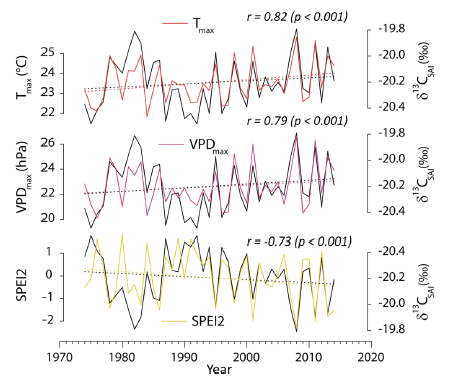
Figure 1: Comparisons of temporal variations in A. araucana δ13C (solid black line) at Sainuco, northern Patagonia with (upper) regional mean (December-January) maximum temperature (Tmax), (middle) mean (December-January) maximum vapor pressure deficit (VPDmax) and (bottom) January Standardized Precipitation-Evapotranspiration Index (SPEI2, calculated over December- January corresponding to January) over the common interval 1974–2014 (41 years. The correlation coefficients between records are indicated.
Tree-ring width (TRW) chronologies have been widely and long-time used to reconstruct past climate variations in the Andes in South America. The use of tree-ring isotopic chronologies is still not widespread in this region although they have proved to be very efficient climate proxies. Araucaria araucana (Molina) K. Koch is a conifer tree species with some multi-century-old individuals that offers an excellent opportunity to measure stable carbon (δ13C) and oxygen (δ18O) isotopes in cellulose from long tree-ring records. Here, we explore whether current or stored carbohydrates are used for A. araucana radial growth and we assess the potential of a tree-ring isotopic record to study past climate variability. Eleven A. araucana cores from a dry and high-elevation forest at the northern border of Patagonia, Argentina (38◦55’S, 70◦44’W) were selected for stable isotopes analyses. The strong correlation between the isotopic composition of the first and second parts of the same ring, but also the strong relationships between δ13C and δ18O records with climate parameters of the current growing season such as temperature, show that tree-rings are built mostly with carbohydrates produced during the current growing season with little or no supply from storage or reserves. This finding leads to reconsidering the interpretation of the legacy effect (i.e. ecological memory effects) based on the previously described strong negative correlation between A. araucana TRW chronologies and previous growing season temperature and suggests a dependence of radial tree growth on the level of development of organs. Regarding climate sensitivity, the A. araucana tree-ring δ13C chronology is strongly related to current summer temperature (r = 0.82, p < 0.001), vapour pressure deficit (VPD; r = 0.79, p < 0.001), precipitation (r = -0.53, p < 0.001) and SPEI2 (r = - 0.73, p < 0.001) (Figure 1). These strong relationships support the use of δ13C of A. araucana tree-ring cellulose to reconstruct past temperature variations at regional scale in relation with large-atmospheric drivers of climate variability such as the Southern Annular Mode. The A. araucana tree-ring δ18O chronology is also correlated with temperature (r = 0.42, p < 0.01) and VPD (r = 0.45, p < 0.01) of the winter preceding the growing season. This suggests that trees are using water from precipitation infiltrated in the soil during the previous recharge period (autumn-winter). The weak correlations of δ18O with current summer atmospheric conditions and the decoupling between δ18O and δ13C, may be due to a high rate of oxygen exchange between sugars and xylem water (Pex) during cellulose synthesis, which dampens evaporative isotopic fractionation.
Référence : Penchenat T., Daux V., Mundo I ., Pierre M., Stievenard M., Srur A., Andreu-Hayles L., Villalba R.
Dendrochronologia 74, 2022 125979.






